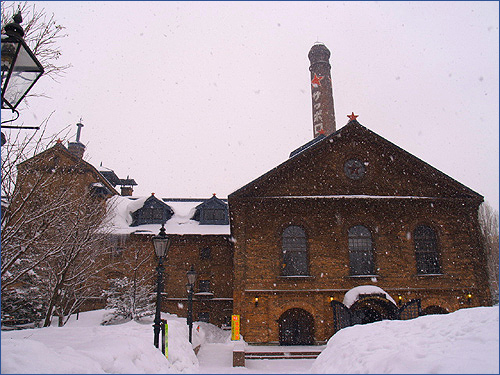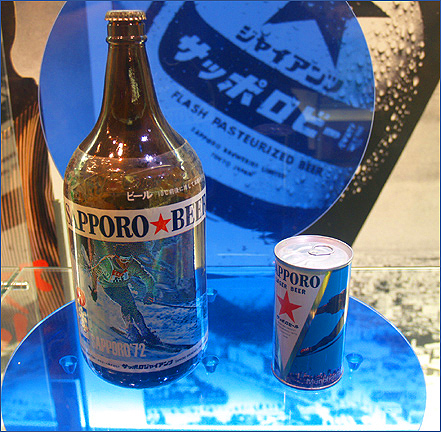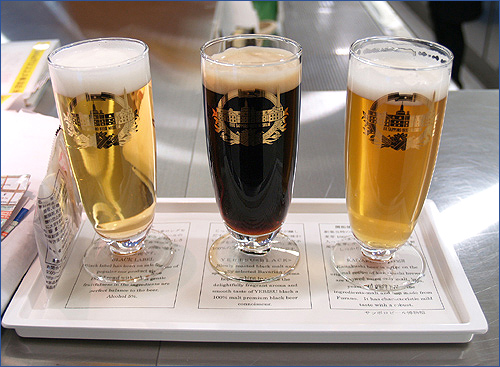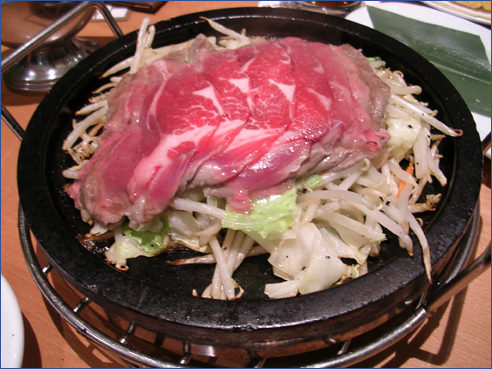Sapporo Beer Museum
Sapporo Beer Museum Offers History and Beer
Museum visitors learn about brewing history in Japan while sampling the wares


Beer came late to Japan -- about 6,000 years later. The Japanese, however, were not slack in the "altering of consciousness through liquid means" department. They had been brewing their rice wine for countless generations before beer found its way over. Beer was first tentatively introduced to the Japanese during the nation's seclusionary Edo Period (1615-1867) by Dutch traders. It did not catch hold at the time.

In the Meiji Period (1867-1912), Japan opened its borders to foreigners and allowed its own citizens to travel abroad. Seibei Nakagawa went to Germany where he earned a Beer Brewery Engineering License. With the discovery of hops in the northern island of Hokkaido, a beer brewery was planned with Nakagawa as its first brewmaster. In 1876, the first Sapporo Beer was sold in Japan.

Over the following decades, beer drinking increased in popularity and became an established pastime. These days it's hard to imagine a Japan without beer, as it has become so firmly entrenched into the Japanese lifestyle. What helped is the fact that a good percentage of Japanese food, from sushi to yaki-tori (chicken skewers), simply goes great with beer.
The Sapporo Beer Museum in Sapporo is a good place for beer lovers to go to learn more about the history of beer brewing in Japan. The Museum has a collection of beer bottles and cans that date back to the late 19th Century. Visitors can also watch beer commercials that span several decades. There are two small bars where one can -- for a small fee -- sample the wares. Two of the beers -- Kaitakushi and Sapporo Classic -- are only available in Hokkaido.

The taste of Sapporo beer, which its admirers harp on about, comes from unique hops that are only produced in certain areas around the world -- areas known for their exceptional beers. Sapporo Brewery prides itself in its quality ingredients and the skill of its brewers. Sapporo beer can be seen as a delicious result of German brewing practices and Japanese attention to detail.

At first, visitors to the Sapporo Beer Museum may be a bit shocked to find a red star emblazoned on its building, and suddenly worry that Communist China has gained a foothold in the Hokkaido Island as a precursor to invasion of the mainland. The red star actually represents the North Star, which was the symbol of the early pioneers in the 19th Century. The red star logo was later changed to a gold star, no doubt to avoid any confusion that Sapporo Beer might be a communist brewski.

Visitors shouldn't try to get too involved in their study of Sapporo's finest brew at the Museum's bar, however. Attached to the museum is the Sapporo Beer Garten, where for just under 4,000 Yen a person can help themselves to all the beer they can drink for 100 minutes. Accompanying the beer are strips of lamb meat cooked on a grill at the customer's table by the customer themselves. This dish is named after the famous Mongol conqueror: Genghis Khan. After 100 minutes of incessant beer guzzling and lamb chomping, the only kingdom you'll be interested in sacking will be the one with the porcelain throne.

Museum visitors learn about brewing history in Japan while sampling the wares

The Sapporo Beer Museum
Ever since man raised himself from his animal-like state of existence and achieved conscious rational awareness, he has used his thought process to devise various and illicit ways of removing this burden of consciousness and returning to his former state. One of the earliest relievers of this burden was the divine elixir known as beer. Beer brewing can be traced back over 6,000 years ago to the resourceful Sumerians. The Sumerians were so taken by this brew they dedicated hymns praising their gods for this divine drink. They even had a goddess of beer brewing.

Old Beer Bottles from the turn of the century
Beer came late to Japan -- about 6,000 years later. The Japanese, however, were not slack in the "altering of consciousness through liquid means" department. They had been brewing their rice wine for countless generations before beer found its way over. Beer was first tentatively introduced to the Japanese during the nation's seclusionary Edo Period (1615-1867) by Dutch traders. It did not catch hold at the time.

The perfect combination: Geisha and beer
In the Meiji Period (1867-1912), Japan opened its borders to foreigners and allowed its own citizens to travel abroad. Seibei Nakagawa went to Germany where he earned a Beer Brewery Engineering License. With the discovery of hops in the northern island of Hokkaido, a beer brewery was planned with Nakagawa as its first brewmaster. In 1876, the first Sapporo Beer was sold in Japan.

A display showing that Sapporo Beer is apparently made by magical gnome-like creatures.
Over the following decades, beer drinking increased in popularity and became an established pastime. These days it's hard to imagine a Japan without beer, as it has become so firmly entrenched into the Japanese lifestyle. What helped is the fact that a good percentage of Japanese food, from sushi to yaki-tori (chicken skewers), simply goes great with beer.
The Sapporo Beer Museum in Sapporo is a good place for beer lovers to go to learn more about the history of beer brewing in Japan. The Museum has a collection of beer bottles and cans that date back to the late 19th Century. Visitors can also watch beer commercials that span several decades. There are two small bars where one can -- for a small fee -- sample the wares. Two of the beers -- Kaitakushi and Sapporo Classic -- are only available in Hokkaido.

Commemorative Beer for the 1972 Winter Olympics which were held in Sapporo
The taste of Sapporo beer, which its admirers harp on about, comes from unique hops that are only produced in certain areas around the world -- areas known for their exceptional beers. Sapporo Brewery prides itself in its quality ingredients and the skill of its brewers. Sapporo beer can be seen as a delicious result of German brewing practices and Japanese attention to detail.

Samples for the studious beer connoisseur
At first, visitors to the Sapporo Beer Museum may be a bit shocked to find a red star emblazoned on its building, and suddenly worry that Communist China has gained a foothold in the Hokkaido Island as a precursor to invasion of the mainland. The red star actually represents the North Star, which was the symbol of the early pioneers in the 19th Century. The red star logo was later changed to a gold star, no doubt to avoid any confusion that Sapporo Beer might be a communist brewski.

Jingisukan (Genghis Khan): a sizzling plate-grill of lamb meat
Visitors shouldn't try to get too involved in their study of Sapporo's finest brew at the Museum's bar, however. Attached to the museum is the Sapporo Beer Garten, where for just under 4,000 Yen a person can help themselves to all the beer they can drink for 100 minutes. Accompanying the beer are strips of lamb meat cooked on a grill at the customer's table by the customer themselves. This dish is named after the famous Mongol conqueror: Genghis Khan. After 100 minutes of incessant beer guzzling and lamb chomping, the only kingdom you'll be interested in sacking will be the one with the porcelain throne.

All's Well in Magical Beerland
Comments
Post a Comment